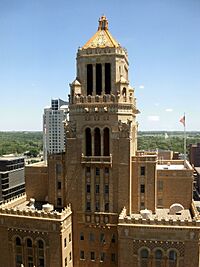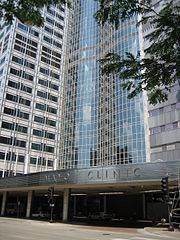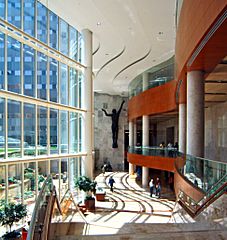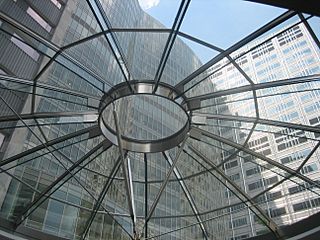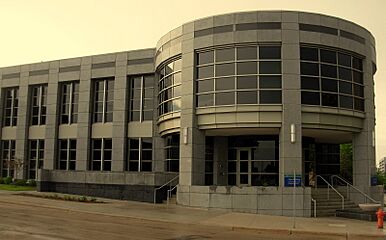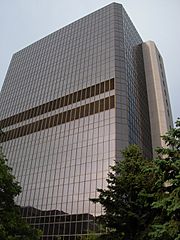Mayo Clinic facts for kids
 |
|
| Private | |
| Industry | Health care |
| Founded | January 27, 1864 Rochester, Minnesota, U.S. |
| Headquarters |
Rochester, Minnesota
,
U.S.
44°1′20″N 92°28′0″W / 44.02222°N 92.46667°W |
|
Area served
|
|
|
Key people
|
|
| Revenue | |
| Total assets | |
|
Number of employees
|
76,000 |
| Divisions |
|
Mayo Clinic (pronounced MAY-oh) is a special kind of hospital and research center in the United States. It's known for bringing together healthcare, teaching, and scientific research. It has three main locations: Rochester, Minnesota; Jacksonville, Florida; and Phoenix/Scottsdale, Arizona.
More than 7,300 doctors and scientists work at Mayo Clinic, along with 66,000 other helpful staff. They are experts at treating very serious or complicated health problems. People often travel from far away to get care there. Mayo Clinic also has a highly-ranked medical school, the Mayo Clinic Alix School of Medicine. They spend over $660 million each year on research and have more than 3,000 full-time research staff.
The Mayo Clinic started in 1864 when William Worrall Mayo opened a medical practice in Rochester, Minnesota. His sons, Will and Charlie Mayo, later helped it grow into the famous Mayo Clinic we know today. Besides the main hospital in Rochester, Mayo Clinic also has big campuses in Arizona and Florida. In 2020, Mayo Clinic also bought a facility in central London, UK. The Mayo Clinic Health System also runs many smaller clinics and hospitals in Minnesota, Wisconsin, and Iowa.
Mayo Clinic has been ranked as the number one hospital in the United States for seven years in a row by U.S. News & World Report. It has also been on Fortune magazine's list of "100 Best Companies to Work For" for many years. Patients from all over the world come to Mayo Clinic, and it performs a very high number of organ and blood transplants in the country.
Contents
How Mayo Clinic Works
Mayo Clinic is a non-profit hospital system. This means it uses its earnings to improve patient care, research, and education, rather than giving profits to owners. Its main campuses are in Rochester, Minnesota; Scottsdale and Phoenix, Arizona; and Jacksonville, Florida. As of 2022, Mayo Clinic has 76,000 employees. This includes over 7,300 doctors and medical residents, plus more than 66,000 other healthcare staff.
Mayo Clinic also partly owns and runs the Mayo Clinic Health System. This system includes over 70 hospitals and clinics across Minnesota, Iowa, and Wisconsin. Additionally, Mayo Clinic operates the Mayo Clinic College of Medicine and Science. This college is a non-profit school that trains medical and health professionals at Mayo Hospitals in Minnesota, Arizona, and Florida.
In 2019, Mayo Clinic started a clinic in London, UK, working with Oxford University Clinic. Later, in 2020, Mayo Clinic became the sole owner of this London facility. This made it Mayo Clinic's first overseas clinic that it fully owned and operated.
The current leader of Mayo Clinic is Dr. Gianrico Farrugia, who is the president and CEO.
Patient Care at Mayo Clinic
In 2022, Mayo Clinic helped more than 1.3 million patients. These patients came from all 50 states in the U.S. and from 138 different countries around the world.
Research and Discoveries
Mayo Clinic researchers work to understand diseases better. They also find the best ways to treat patients and turn new lab discoveries into real-world medical treatments. As of 2022, about 5,500 doctors and scientists were involved in research. In 2022, Mayo Clinic spent over $1 billion on research. This research led to 9,275 articles published in scientific journals.
Medical Education
The Mayo Clinic College of Medicine and Science (MCCMS) started in 1915. It offers many programs to train future doctors and health professionals. These programs are closely connected to Mayo Clinic's patient care and research.
MCCMS has five main schools:
- Mayo Clinic Alix School of Medicine trains students to become medical doctors.
- Mayo Clinic School of Graduate Medical Education offers over 300 programs for doctors who want to specialize in different medical fields.
- Mayo Clinic School of Health Sciences trains students for 60 different health science jobs.
- Mayo Clinic School of Continuous Professional Development helps doctors and nurses keep learning throughout their careers.
- Mayo Clinic Graduate School of Biomedical Sciences is for students who want to do research and earn master's or Ph.D. degrees in science.
History of Mayo Clinic
How It All Began
Mayo Clinic started with Dr. William Worrall Mayo (1819–1911). He was born in England and moved to the United States in 1846. He earned two medical degrees, which was unusual for doctors back then. In 1864, Dr. Mayo opened his own medical office in Rochester, Minnesota.
His two sons, William James Mayo (Dr. Will) and Charles Horace Mayo (Dr. Charlie), grew up in Rochester and also became doctors. Dr. Will joined his father's practice in 1883, and Dr. Charlie joined in 1888.
A big tornado hit Rochester on August 21, 1883. It caused many deaths and injuries. Dr. Mayo was put in charge of helping the injured. He asked Mother Alfred Moes, who led a group of teaching nuns called the Sisters of Saint Francis, for help with nurses.
After the tornado, Mother Alfred suggested that the Sisters build a hospital in Rochester. Dr. Mayo and his sons agreed to provide the medical care. They made this agreement with a handshake. On September 30, 1889, Saint Mary's Hospital opened, with the three Mayo doctors working there.
Growing as a Team
As medicine became more specialized, the Mayo brothers invited other doctors to join them. This is how their family practice grew into a "group practice." This meant many doctors with different specialties worked together to care for patients. Some of the first doctors to join were Augustus W. Stinchfield, Christopher Graham, and Henry Plummer.
Dr. Henry Stanley Plummer was very important. He helped treat thyroid diseases. He also worked with the Mayo brothers to add more medical specialties beyond just surgery. Dr. Plummer was also very creative. He designed many systems that Mayo Clinic still uses today, like the "dossier" medical record. This system helped doctors share patient information easily.
Expanding Across the Country
The Mayo brothers became very famous surgeons. In 1919, they and their wives gave almost all their money, land, and buildings to turn their private practice into a non-profit organization. This meant that instead of making money for themselves, the clinic would use its funds to help patients, teach, and do research.
After World War II, Mayo Clinic continued to grow in Rochester. In 1972, the Mayo Medical School opened.
In 1986, Mayo Clinic officially joined with Saint Marys Hospital and Rochester Methodist Hospital. That same year, Mayo Clinic expanded to Florida, thanks to a large land donation. Then, in 1987, they opened a campus in Scottsdale, Arizona, and another in Phoenix, Arizona, in 1998. In 1992, the Mayo Clinic Health System started. This system created a network of smaller clinics and hospitals in Minnesota, Iowa, and Wisconsin.
In 2019, Mayo Clinic invested in a hospital in the United Arab Emirates. In 2020, Mayo Clinic opened its own health clinic in central London, UK, which it later fully owned.
Important Medical Discoveries
Mayo Clinic has made many important contributions to medicine and science:
- In the early 1900s, Dr. Henry Plummer created the idea of a "group practice." This meant doctors from different specialties worked together. He also designed an integrated medical record system. This system allowed doctors to share patient information much better.
- In 1905, Mayo Clinic developed a way to quickly check if a patient had cancer during surgery.
- In 1915, Mayo Clinic started the first program for doctors to get advanced training after medical school.
- In the 1920s, Dr. Albert Compton Broders created the first way to grade tumors.
- In 1935, Mayo Clinic opened the first hospital-based blood bank in Rochester.
- During World War II, Mayo Clinic helped the U.S. Army solve a problem with pilots blacking out during high-speed turns. They developed the "G-suit," which helped prevent blood from pooling in pilots' legs.
- In 1950, two Mayo Clinic doctors, Edward C. Kendall and Philip S. Hench, won the Nobel Prize in medicine. They discovered cortisone, a very important medicine.
- In 1969, Mayo Clinic doctors performed the first hip replacement surgery in the U.S. that was approved by the Food and Drug Administration.
- In 1973, Mayo Clinic bought the first CT scanner in the U.S. A CT scanner uses X-rays to create detailed pictures inside the body.
- In 2001, Mayo Clinic helped develop a fast DNA test to find anthrax.
- In 2013, Mayo Clinic started a study using a patient's own cells to try and heal heart damage.
- In 2014, Mayo Clinic worked with Apple to develop the Apple Health and HealthKit apps. These apps help people keep track of their personal health information.
- In 2020, Mayo Clinic started a program to treat COVID-19 patients in their homes using virtual care.
- In 2018, Mayo Clinic and UCLA used spinal cord stimulation to help a paralyzed man briefly stand and walk with help.
- As of 2023, Mayo Clinic has treated over 10,000 patients with proton beam therapy. This is a very advanced type of radiation treatment for cancer.
Buildings and Art
As Mayo Clinic grew, it needed more space. In 1914, Mayo Clinic opened the world's first building designed specifically for a multi-specialty group practice. This building made it easier for patients and staff to move between different medical areas. It also brought research and education closer to patient care.
The 1928 Mayo Clinic building, later named the Plummer Building, is also very famous. It's known for its beautiful design and is listed as a historic place. It has large bronze entry doors that weigh 4,000 pounds each. These doors are closed to remember important events or people, like the deaths of the Mayo brothers or the victims of the September 11, 2001, attacks.
Other important Mayo Clinic buildings include the Mayo Building (Rochester, Minnesota) (1955), Guggenheim Building (1974), Gonda Building (2001), and the Discovery Square building (2019).
Mayo Clinic also believes that art can help with healing. Over the years, they have collected many artworks that are displayed across their campuses. These include works by famous artists like Andy Warhol, Auguste Rodin, and Alexander Calder.
Innovation at Mayo Clinic
Mayo Clinic uses a lot of technology to help patients. They have adopted over 15,000 mobile devices from Apple, like iPads and iPhones, for patient care. They also created an app called Synthesis Mobile that connects many of their health systems. Other apps help patients see their medical records or ask doctors for help. In 2014, Mayo Clinic worked with Apple to develop the HealthKit app. This app helps people stay healthy and warns them about certain health signs.
The Mayo Clinic Center for Innovation was started in 2008. Since then, it has worked on more than 270 different projects to find new ways to improve healthcare.
In 2018, Mayo Clinic partnered with Mytonomy, a company that provides video content for cancer patients. In 2019, Mayo Clinic teamed up with Google for healthcare innovation and cloud computing. Google even planned to open a facility in Rochester, Minnesota, for Mayo Clinic.
In 2020, Mayo Clinic and NTT Venture Capital invested in a software company that develops biomedical tools. In 2023, Mayo Clinic shared that they are using AI (Artificial Intelligence) technology. This AI helps them write content in simple language, choose inclusive words, and make information easy to find online.
Mayo Clinic Rankings
Since 2016, Mayo Clinic in Rochester has been ranked as the #1 overall hospital in the United States by U.S. News & World Report. This ranking considers almost 5,000 hospitals and looks at 16 different medical specialties. Mayo Clinic, Rochester, was ranked in the top 10 for almost all 16 specialties. It was even ranked #1 in 8 of the 12 specialties that use a lot of data for their rankings.
In 2021–22, Mayo Clinic, Rochester, was again ranked as the #1 overall hospital in the United States by U.S. News & World Report.
|
Ranked 1st
|
Ranked 2nd
|
Ranked 3rd–6th
|
High-Performing
|
See also
 In Spanish: Clínica Mayo para niños
In Spanish: Clínica Mayo para niños
- Mayo Clinic Arizona
- Mayo Clinic Cancer Center
- Mayo Clinic Florida
- Mayo Clinic Hospital (Rochester), Saint Marys Campus, Methodist Campus





